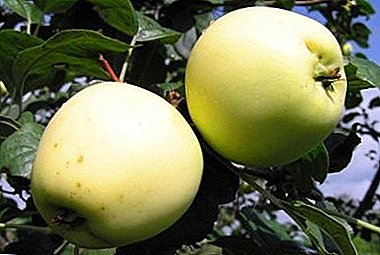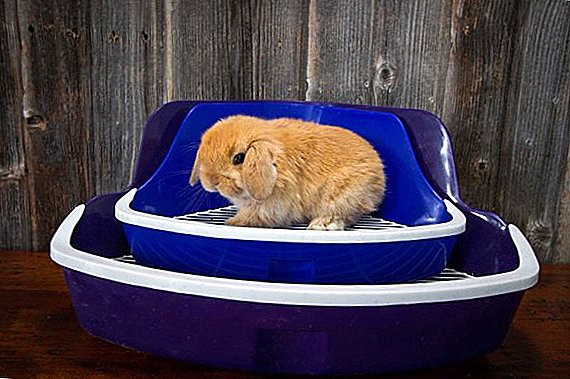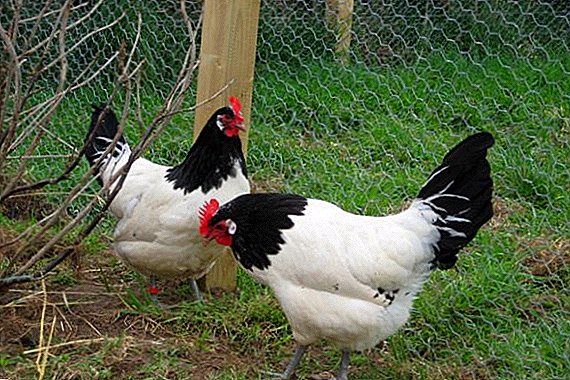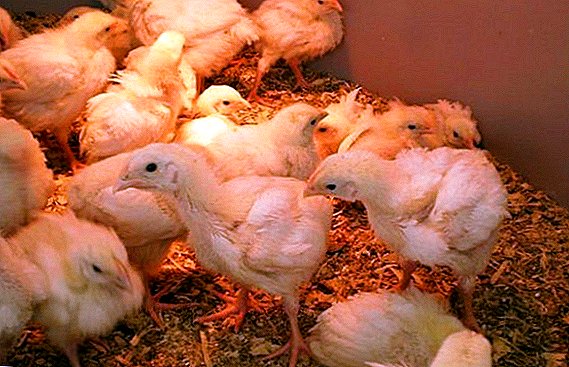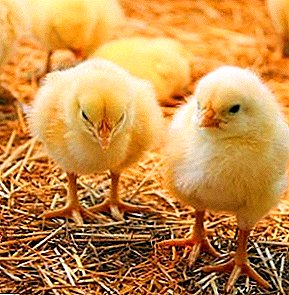 Broilers have long been raised in poultry farms and households. There are reasons for that - such chickens are relatively unpretentious in care and grow quickly. But they also periodically deliver troubles to their masters. One of the most common problems is diarrhea in birds, so this problem requires separate consideration.
Broilers have long been raised in poultry farms and households. There are reasons for that - such chickens are relatively unpretentious in care and grow quickly. But they also periodically deliver troubles to their masters. One of the most common problems is diarrhea in birds, so this problem requires separate consideration.
Causes of disorder in broilers
The occurrence of diarrhea in chickens or adult chickens can be caused by such factors:
- intake of poor quality food or, on the contrary, intake of overly fortified food;
- abrupt change of diet (from grain to greens and back);
- poisoning;
- seasonal (spring) avitaminosis;
- the stay of chickens in a polluted house, which is especially dangerous for young animals;
- severe stress or hypothermia.
Read more about chick diseases and how to treat them.
In addition, there is another group of causes that can cause diarrhea.  These are infectious diseases of birds, the most common of which are:
These are infectious diseases of birds, the most common of which are:
- salmonellosis. Chicks are mostly susceptible to it, and diarrhea is one of the main symptoms;
- pasteurellosis (he is bird cholera). It is usually diagnosed in adult birds, and is difficult to treat - often infected individuals are simply slaughtered;
- pullorosiswhich can occur regardless of age. The insidiousness of this disease is that it often turns into a chronic form, which requires constant and intensive care for broilers. Another feature - pullorosis, like salmonellosis, is transmitted to humans;
- parasitic histomoniasisknown as blackhead disease.
Important! The cause of the disease may be a long stay of a bird in an open area like a pen (especially if there are other animals nearby or the remains of their vital activity are visible).
Many people know about these reasons, but with the maintenance of large livestock, it is not always possible to immediately calculate the nestling that has fallen down, which becomes dangerous for the rest. If you do not do it in time, then diagnostics will soon come to the fore.
Diagnosis of diarrhea
Correctly diagnosed - the key to successful treatment, so the most appropriate will be the delivery of litter in the veterinary laboratory. This will clarify the cause of the disease, differentiate the ailments with similar symptoms and prescribe treatment.
But in practice, bird owners do not always turn to specialists: it happens that there is no veterinarian nearby, and the situation requires an urgent solution.  The main thing - do not panic. Moreover, experienced owners know how to determine the cause of diarrhea by the nature of the discharge. We will listen to their recommendations.
The main thing - do not panic. Moreover, experienced owners know how to determine the cause of diarrhea by the nature of the discharge. We will listen to their recommendations.
It will be useful for you to learn how to feed the chickens correctly in the first days of life.
White diarrhea in broiler chickens
Frequent whitish liquid droppings are evidence that diarrhea is caused by infectious diseases. This is usually an initial salmonellosis or pullorosis.  The following symptoms should bring the same thought:
The following symptoms should bring the same thought:
- slow breathing through a constantly open beak;
- lethargy of the bird and the reluctance of chicks to move;
- developmental lag (in the case of pullorosis, sick individuals are almost half the size of healthy peers).
Did you know? Chicken breed Ayam Chemani has a gene that causes hyperpigmentation. Because of this, the birds are completely black, and not only outside, but inside as well - their organs and even their bones are black.
These manifestations are most dangerous for chickens less than a month. If the infection occurred in the incubator, the chances of survival, alas, are extremely small. Monthly broilers with diarrhea are considered conditionally healthy, and can be treated.
Brown diarrhea in chickens
Having noticed traces of dark brown diarrhea, pay attention to the bird - it is likely that broilers develop acute intestinal pasteurellosis. It is recognized by:
- mobility - the chicken is blunt and hardly moves from its place, and its feathers are ruffled;
- decrease or complete lack of appetite;
- constant thirst;
- change the color of the comb (it becomes pale or blue);
- copious mucus from the nasal openings;
- the presence in the litter of blood fragments.
All these symptoms, along with complicated breathing, echo the signs of coccidiosis.  Unlike extensive pasteurellosis, it is completely treatable, so if brown diarrhea is detected, it is advisable to send feces to the laboratory - this will allow the veterinarian to clarify the diagnosis and prescribe treatment.
Unlike extensive pasteurellosis, it is completely treatable, so if brown diarrhea is detected, it is advisable to send feces to the laboratory - this will allow the veterinarian to clarify the diagnosis and prescribe treatment.
Read also how to cure coccidiosis and pasteurellosis of poultry.
Green, yellow diarrhea in broilers
Such coloring liquid litter usually indicates misses in feeding:
- if there is a light green diarrhea, then the reason is poor wet mashies;
- a darker shade of green secretions often appears during a sharp transition from grain feed to green;
- yellow feces are noticeable when using poor-quality grain mixtures and animal feed.

Important! It is best to buy day-old chickens on poultry farms or from reputable vendors - rejected chicks often enter the markets and their health raises questions.Such manifestations are non-infectious, and therefore relatively safe and easy to treat.
Another thing is the change in the color of the stool as a result of the development of the histomonosis. This parasitic disease is transmitted through worms and nematodes, which makes it particularly dangerous for birds that are kept open-range.
Broilers with their "sedentary" lifestyle rarely get sick, but the owners still need to remember the symptoms of a dangerous ailment in the form:
- decreased activity and lack of appetite;
- lowering the wings in chickens;
- darkening of the skin on the head: in young animals, it turns black, and in adult chickens it becomes dark blue;
- lowering the temperature;
- changes in the behavior of a sick bird - it hides its head under its wings, and in case of a massive lesion, sick chickens get stuck in flocks.
 Fortunately, broilers tolerate histomoniasis more easily than other birds (like turkeys), but 1-3 weeks of exacerbation still leave the owners in the dark - the bird may recover, remaining a carrier of infection or die.
Fortunately, broilers tolerate histomoniasis more easily than other birds (like turkeys), but 1-3 weeks of exacerbation still leave the owners in the dark - the bird may recover, remaining a carrier of infection or die.It will be useful for you to learn about broiler breeds, how to raise broiler chickens, and also how to build your own broiler cages.
How to treat
The arsenal of tools used is quite extensive. The most popular of them are such compositions:
- chloramphenicol. It is used in the fight against salmonellosis. Reception is carried out at the rate of 30-50 mg / kg of body weight, three times a day;
- Coccidin. From the name it is clear that it is taken for the treatment of diarrhea caused by coccidiosis. Within 3-5 days, 250 mg of this powder are added to 1 kg of feed, after which the dose is reduced to 125 (this rate is maintained for another week). Analogues of the drug - Zolen and Sulfadimezin;
- furazolidone. His "specialization" is the treatment of pullorosis and pasteurellosis. Dosage depends on age. For example, chickens up to 10 days in the feed pour 0.02 mg (this is per 10 individuals), whereas two-week-old young animals need 0.03 mg. The adult rate is 0.04 mg;
- metronidazole from histomoniasis. Mounted in the feed for 5 days (20-25 mg / kg live weight);
- "Biomitsin". This is the most versatile tool. It is diluted in water at the rate of 1 mg / 1 l or injected intramuscularly (2-3 mg per 2-vat syringe with water).

Did you know? The number of chickens on the planet exceeds the number of people about 3 times.
All of these drugs are used to treat infectious diseases and strictly by prescription by a veterinarian. He also adjusts the dosage according to the situation.
It is somewhat easier to cure diarrhea caused by improper diet - it is revised by removing the ingredients that cause such complications. Here, too, has its own nuances.
So, if digestion problems result from the use of a large amount of greenery, it is replaced by grain, pouring oatmeal or rice water into the troughs.
If it turns out that the reason is poor-quality food, broilers are watered with disinfectants (weak furatsilin, potassium permanganate). In parallel, you can use chloramphenicol. Baking potatoes or boiled eggs served in the ground form are used as fixing agents.  Starting treatment, do not forget about the isolation of sick birds, as well as disinfection of premises or cages, feeders and drinkers.
Starting treatment, do not forget about the isolation of sick birds, as well as disinfection of premises or cages, feeders and drinkers.
Prevention
Such troubles are better to prevent than to cure. This is especially true for a small home farm, where a couple of chickens who have fallen asleep become a serious threat to their fellows.
Important! It is advisable to minimize the risk of rodents in the house.Prevention comes down to simple, but still effective measures:
- even before the birds are settled, the rooms, cages, and also the inventory must be disinfected - first, the surfaces are treated with a blowtorch (as an option, a 20% solution of freshly extinguished lime is applied to the walls), and then sprayed with a solution. Plastic feeders or drinkers enough to immerse in a strong disinfecting solution for not less than half an hour;
- ensure normal ventilation;
- separate chickens and adult chickens;
- constant quality control of feed;
- regular replacement of bedding material - the wet layer is immediately replaced with a dry one, removing the remaining dirt from the floor;
- It is equally important to exclude contacts of broilers with representatives of other breeds and species (they may be carriers of intestinal helminths);
- finally, using a feeding regimen suitable for age. In the case of young stock, it is better to take easily digestible products - oatmeal and yogurt, cottage cheese and millet, as well as special granulated mixtures. The transition to a different type of feed is carried out gradually, adding new ingredients in small doses.

Did you know? Some people experience actorophobia - the so-called fear of chickens.
These procedures are well known to farmers and those who have been breeding broilers for a long time.
Keeping them in mind, even a novice can handle the birds. Fortunately, such chickens take up little space, and the food supply is now available to everyone. The main thing is to properly use such stocks and constantly monitor the health of feathered pets.
We recommend reading how and how to treat noncommunicable diseases in broiler chickens, as well as what to do if broilers sneeze and wheeze.
Now you know why the broilers are beginning to reproach, how to determine the exact cause of such a misfortune, and what its treatment amounts to. We hope this information will be useful to you, and you will be able to prevent such difficulties, and the chicks will delight the eye with their well-groomed appearance. Successes on a farmstead!


